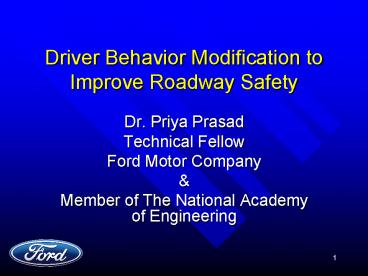Driver Behavior Modification to Improve Roadway Safety - PowerPoint PPT Presentation
1 / 19
Title:
Driver Behavior Modification to Improve Roadway Safety
Description:
Driver Behavior Modification to Improve Roadway Safety Dr. Priya Prasad Technical Fellow Ford Motor Company & Member of The National Academy of Engineering – PowerPoint PPT presentation
Number of Views:144
Avg rating:3.0/5.0
Title: Driver Behavior Modification to Improve Roadway Safety
1
Driver Behavior Modification to Improve Roadway
Safety
- Dr. Priya Prasad
- Technical Fellow
- Ford Motor Company
- Member of The National Academy of Engineering
2
Vehicle (cars light truck) Occupant Fatalities
in USA
TSF, NHTSA
3
Changes in Road Fatalities between 1994 2004
UMTRI-2006-26
4
Safety Vision
Sweden Zero Fatality Vision Netherlands Zero
Fatality Vision Japan 50 Reduction in
Fatalities by 2015 Australia 40 Reduction in
Fatalities by 2010 United Kingdom 40 Reduction
in Fatalities by 2010 Canada 30 Reduction in
Fatalities by 2010 European Union 30 Reduction
in Fatalities by 2010 United States 33 Reduction
in Fatalities by 2008
5
Holistic Safety Approach
- Modification of driver behavior
- Vehicle safety improvements
- Infra-structure improvements
- Enforcements of traffic laws
6
Driver Behavior Factors affecting Fatalities
- Seat belt wearing
- Alcohol
- Speed
- Driver age/experience
7
Factors for Fatalities NOT Wearing Restraints
2004
TSF, NHTSA
8
Factors for Fatalities Alcohol Involvement
DRIVERS with BAC 0.08 g/dL or HIGHER (2005)
DOT HS 810616
9
Factors for Fatalities - Speeding
2005
DOT HS 810629
10
Vehicle (cars light truck) Occupant Fatality
Rate in USA
TSF, NHTSA
11
Holistic Countermeasures
- Policy
- Education
- Enforcement
- Technology
12
Belt Wearing Rates
- Primary belt wearing laws
- Educational campaigns
- Strict enforcement
- Technological intervention Fords Belt-Minder,
Seat-belt interlocks, Belt comfort and
convenience improvements
13
Alcohol Impaired Driving Reduction
- lt0.08 BAC law
- Zero-tolerance laws (proposal in some European
countries - Strict enforcement of laws
- High fines (Japan)
- Educational campaigns
- Technology alcohol interlocks
14
Technology Status
- Technology has a role
- Current technology effective for repeat offenders
- Mass scale introduction expected only after ten
years - Consumer acceptance may still be an issue
- Total fleet saturation will take substantially
longer time (additional 15 years)
15
Speed
- Speed limits
- Speed limit enforcement
- Educational campaigns
- Technology Roadside and traffic light cameras
(highly effective in Europe) - Intelligent Speed Adaptation- Information and
control (European Experiment)
16
Driver Demographics
- Teen aged drivers is an issue, some from
inexperience and some from risky behavior - Graduated Driver Licensing and enforcement
- Parental education regarding risk factors for
teenagers
17
Driving Skills for Life Program
- A collaboration between Ford and the GHSA
- New website launched in May- over 500 logins per
day, further enhancements planned - Summer camp in August 600 teens trained, 100
parents participated - 30-min. documentary to be launched soon, with PR
campaigns on national media (TV, Radio,
print/online - Investigating other opportunities
18
Potential Technological Interventions for Teenage
drivers
- Parents can request for the following
- Smart seatbelt interlocks
- Smart alcohol interlocks
- Smart license to control vehicle acceleration and
speed - Above is technologically feasible, but needs
demand from parents
19
Technology Vs Policy
- Technology will play a role in modifying driver
behavior, but the effect of technological
intervention will be in the long term due to the
time taken to reach fleet saturation. - Therefore, a policy based on enforcement and
education will have a faster effect.































